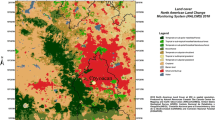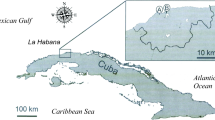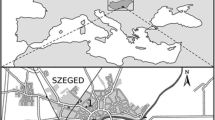Abstract
The pollen grains in the atmosphere in different geographical areas differ according to the species present, the pollination seasons and pollen grain concentrations, but possibly the greatest contributors to this variability are the meteorological conditions. The aim of our research is to establish a possible correlation between Parietaria pollen concentration and meteorological conditions during the period from 1991 to 1995 in the town of Alassio (north–west Italy). As far as vegetation is concerned, the Mediterranean climatic conditions support the blooming of extensive grasslands in the environment surrounding the town; these grasslands mainly comprise Urticaceae and shrubs. The study demonstrates that the most influential parameters affecting the Urticaceae grain concentration upsurge are the absence of rainfall, a maximum daily temperature of about 21 °C, and a diurnal temperature range of about 5 °C. Moreover, our aeropalinological study indicates that this last parameter has the greatest influence on Urticaceae pollination. In fact, an increase in diurnal temperature range could be responsible for a dehydration of pollens resulting in a loss in mass. This grain lightness and volatility would ultimately permit atmospheric dispersion if there is a significant wind speed. On the other hand, days with rain or high relative humidity make pollens heavier, preventing them from flying long distances and therefore partially explaining the decline in airbone pollen concentration.
Similar content being viewed by others
Avoid common mistakes on your manuscript.
Introduction
Pollens are among the major causes of respiratory allergy diseases, especially in Europe where their prevalence is increasing (Bousquet et al. 1986; European Allergy White Paper 1997). The pollen grains in the atmosphere in different geographical areas vary with the species present, pollination seasons and pollen grain concentrations, and it is quite likely that much of this variability is due to meteorological conditions (Ariano et al. 1994; Dei Mar Trigo et al. 1996; Puc and Wolski 2002; Ruiz de Clavijo et al. 1988; Via et al. 1989).
The Urticaceae are a family of herbaceous plants and small bushes including 45 genera and 1,000 species that usually grow in warm and tropical zones. The name Parietaria derives from its natural habitat: the plant usually grows in cracks or at the base of walls (from the Latin Paries, ietis) stones, etc. The pollen of Urticaceae is small (12–18μm) spheroidal, spiculated and has three to five pores (D’Amato 1995). The family comprises Parietaria officinalis, P. judaica, P. mauritanica, and P. cretica, the first two being the most common of all. P. officinalis grows on ridges or in mountain areas (below 1,000 metres above sea level) and can be found in Spain, France, Austria, Bulgaria, Slovakia, the Czech Republic, Romania, Russia and northern Italy (Cvitanovic 1999; D’Amato 1995; Hernandez Prieto et al. 1998). In contrast, P. judaica is a hermophile and heliophilous species, therefore walls located in urban environments along the coasts are its ideal habitat.
The aim of our research was to establish a possible connection between Parietaria pollen concentration and meteorological conditions during the period from 1991 to 1995 in the town of Alassio. This coastal city, located in the north-west of Liguria (Italy: 44°00′ north; 8°10′ west), is characterised by a Mediterranean climate with an average temperature of 13 °C in the coldest month of the year (January) and 27 °C in the warmest (August). Rainfall is quite high throughout the year though more abundant in winter; most days are windy or breezy with northerly winds more frequent in the wintertime and southerly winds more frequent in the summertime. As far as vegetation is concerned, the Mediterranean climate allows extensive grasslands to flourish in the environment surrounding the town; these grasslands are mainly composed of Urticaceae and shrubs (D’Amato et al. 1992, 1998; Papageorgiou 1999; Terzioglu et al. 1998).
Materials and methods
Pollen sampling was carried out for 5 years (1991–1995) using a Burkard automatic volumetric pollen and spore trap located on the roof of Alassio Hospital (D’Amato et al. 1983; Hernandez Prieto et al. 1998; Portnoy et al. 2000; Vidal et al. 2001). This collector is made of a weathercock that orientates the nozzle according to the direction of the wind and a vacuum pump that aspirates a constant flow of air (10 l/min) through the nozzle. In this way, pollen grains become stuck on a plastic ribbon soaked in silicone placed on a revolving cylinder that makes one complete revolution per week. The trap was placed 16 metres above the ground and the sampler was constantly on. In post-processing, slides were prepared using basic fucsin and the data interpreted according to the standard guidelines of the Italian Association for Aerobiology. Overall concentrations, expressed in grains/m3 air, were obtained as a daily average; the pollens were then counted and observed by optical microscope, using a 40 × objective for “tangent fields” readings.
Since Urticaceae pollens are not present in significant amounts in December, January and February (D’Amato et al. 1983; Hernandez Prieto et al. 1998) pollen values were examined only in the period between March and November. For each year of the study, 2 days were selected: the day on which the pollen concentration reached its maximum value and a day, randomly selected, in which the pollen concentration was zero.
For both days a set of meteorological parameters were observed to establish a possible correlation: wind speed (km/h), atmospheric pressure (kPa), maximum temperature (°C), minimum temperature (°C), diurnal temperature range (°C), relative humidity (%) and finally rainfall (mm). These meteorological data were gathered by Alassio’s Istituto Salesiano, which is about 100 m away from the Burkard sampler.
Average meteorological conditions for the 5 days of maximum pollen concentration were compared with averages of the 5 days in which pollination values were zero. Moreover, meteorological parameters recorded 1 and 2 days before the days of maximum pollen concentration were compared with those found 1 and 2 days before the days of zero pollen concentration.
Daily values were compared, using a paired t-test to assess significance.
Results
The monthly pollen concentrations in the years from 1991 to 1995 are shown in Fig. 1; the highest values were found in March, May and June while the lowest were in August and November. The highest ever monthly concentration was recorded in June 1995 (approximately 2,600 grains/m3). In the same month the highest ever weekly concentration (700 grains/m3) was also registered. Moreover, other remarkable levels were recorded in March 1994 (about 1,000 grains/m3month), in May 1995 (1,231 grains/m3month) and in November 1993 (1,258 grains/m3month). Table 1 outlines the days that registered the maximum pollen concentration and the meteorological values associated with the event.
Average meteorological conditions on days with maximum and zero pollen concentrations are reported in Table 2. The maximum temperature (t = 2.25; P = 0.05), and the diurnal temperature range (t = 3.948; P = 0.004) were significantly higher on days with maximum pollen concentration than on those with zero pollen concentration. In contrast, a significantly lower rainfall (t = 3.911; P = 0.004) on the days with zero pollen can be noted.
A statistical analysis comparing meteorological conditions observed during the days immediately prior to the maximum pollen concentration and those prior to days of zero pollen concentration is presented in Table 3: only the diurnal temperature range was significantly higher (t = 2.371; P = 0.045).
An attempt to study meteorological conditions 2 days before the pollen peaks and two days before the zero pollen concentrations yielded the same results (Table 4).
Table 5 shows a meteorological comparison between the peak days and 1 and 2 days beforehand. It can be seen that the maximum temperature was constantly mild (about 21 °C). In contrast, there was a slight reduction in the minimum temperature resulting in an increase of almost 1 °C in the diurnal temperature range. Although there was a moderate rise in wind speed and atmospheric pressure, the rainfall seems to be the most important parameter determining the Parietaria pollen peak; in fact a strong reduction in the amount of rainfall was registered during the 3 days, though it was not statistically significant: from about 6 mm to 0 mm.
A similar analysis was performed on the days of zero pollen concentration. As shown in Table 6, there is a quite evident declining trend in temperature; an irregular reduction in maximum and minimal temperature explains the decrease in diurnal temperature range. As far as the other parameters are concerned, an overall drop in atmospheric pressure and a significant (P = 0.005) increase in rainfall (confirming the rise of relative humidity) were recorded.
Discussion
In the Mediterranean area, Parietaria has two long pollination periods: the first one begins in spring and persists until the first months of summer (D’Amato et al. 1983; Hernandez Prieto et al. 1998). Daily average values range from 100 to 1,000 grains/m3 and are recorded from the end of April to the beginning of June, depending on climate and region. The second pollination period begins in August and continues until October (D’Amato et al. 1983). In Alassio the Urticaceae pollination season is particularly long and the pollen is present all year round, but in our study the analysis of the pollen concentrations from 1991 to 1995 allowed us to outline two Parietaria pollination peaks: the first one from May to June and the second one from October to November. In particular, we recorded the highest peak ever in June 1995 (2,584 grains/m3); this probably resulted from the unusually high temperatures and the absence of precipitation during that Spring.
The biological increase of such plants is strongly influenced by meteorological variables (Scheiter et al. 2002). Previous studies suggested that Urticaceae pollination is influenced by the amount of rainfall, relative humidity and, in particular, by maximum daily temperature (Dvorin et al. 2001; Galan et al. 2000; Laaidi et al. 2001; Puc and Wolski 2002). Such studies demonstrated that there is a statistically based correlation between maximum daily temperature and Urticaceae pollen concentration (Galan et al. 2000); in fact, in our study, Parietaria has a long spring and autumnal blooming period which is influenced by the same well-known weather parameters. Moreover, our survey demonstrated that there are also other atmospheric conditions, such as rainfall and diurnal temperature range, to take into account when attempting a correlation.
In fact, among all the parameters considered, a significant increase in diurnal temperature range encourages maximum pollen concentration. In contrast, a significant decline in rainfall on days of maximum pollen concentration is quite evident in comparison with days on which the pollen concentration is zero (Galan et al. 2000). These results are also confirmed by the study of conditions 2 days prior to blooming; since the maximum temperature was constantly high and the minimum temperature was slightly decreasing, a rise of almost 1° in diurnal temperature range was registered. Although there was a moderate rise in wind speed and atmospheric pressure, rainfall seems to be the most important parameter determining Parietaria blooming: in fact, a strong reduction in rainfall was recorded, from about 6 mm to 0 mm, (although this was not statistically significant).
On the other hand, from the analysis of the 2 days prior to a null pollen concentration, it is clear that a reduction in diurnal temperature range was registered and the other recorded parameters indicate an overall decline in atmospheric pressure and a significant (P = 0.005) increase in rainfall, confirming the rise of relative humidity.
Our study demonstrates that the parameters having most influence on the Urticaceae grain concentration are the absence of rainfall, a maximum daily temperature of about 21 °C and a diurnal temperature range of about 5 °C.
Moreover, according to our aeropalinological study, it seems that this last parameter has the greatest influence on Urticaceae pollination. In fact an increase in diurnal temperature range could be responsible for a dehydration of pollen resulting in a loss in mass. This grain lightness and volatility will ultimately result in air dispersion when a significant wind speed occurs. On the other hand, days with rain or high relative humidity make pollen grains heavier, preventing them from flying long distances and therefore partially explaining the differences in air pollen concentration.
References
Ariano R, Panzani RC, Chiapella M, Augeri G (1994) Pollinosis in a Mediterranean area (Riviera Ligure, Italy): ten years of pollen counts, correlation with clinical sensitisation and meteorological data. J Invest Allergol Clin Immunl 4:81–86
Bousquet J, Hewitt B, Guerin B, Dhivert H, Mehel FB (1986) Allergy in the Mediterranean area II. Cross allergenicity among Urticaceae pollens (Parietaria and Urtica). Clin Allergy 16:57–64
Cvitanovic S (1999) Allergy to Parietaria officinalis pollen. Croat Med J 40:42–48
D’Amato G (1995) Patologia allergica respiratoria. Kurtis, Milano
D’Amato G, Cocco G, Liccardi G, Melillo G (1983) A study on airborne allergenic pollen content of the atmosphere of Naples. Clin Allergy 13:537–544
D’Amato G, Dal Bo S, Bonini S (1992) Pollen-related allergy in Italy. Ann Allergy 68:433–437
D’Amato G, Spieksma FT, Liccardi G, Jager S, Russo M, Kontou-Fili K, Nikkels H, Wuthrich B, Bonini S (1998) Pollen-related allergy in Europe. Allergy 53:567–578
Dei Mar Trigo M, Cabezudo B, Recio M, Toro FJ (1996) Annual daily and diurnal variations of Urticaceae airborne pollen in Maiag. Aerobiologia 12:85–90
Dvorin DJ, Lee JJ, Belecanech GA, Goldstein MF, Dunsky EH (2001) A comparative, volumetric survey of airborne pollen in Philadelphia, Pennsylvania (1991–1997) and Cherry Hill, New Jersey (1995–1997). Ann Allergy Asthma Immunol 87:394–404
European Allergy White Paper (1997) Allergic diseases as a public health problem. UCB Institute of Allergy
Galan C, Alcazar P, Carinanos P, Garcia H, Dominguez-Vilches E (2000) Meteorological factors affecting daily Urticaceae pollen counts in south-west Spain. Int J Biometeorol 43:191–195
Hernandez Prieto M, Lorente Toledano F, Romo Cortina A, Davila Gonzalez I, Yges E, Calvo Bullon A (1998) Pollen calendar of the city of Salamanca (Spain). Aeropalynological analysis for 1981–1982 and 1991–1992. Allergolog Immunopathol 26:209–222
Laaidi K (2001) Predicting days of high allergenic risk during Betula pollination using weather types. Int J Biometeorol 45:124–132
Papageorgiou PS (1999) Particularities of pollen allergies in Greece. Pediatr Pulmonol Suppl 18:168–171
Portnoy J, Landuyt J, Pacheco F, Flappan S, Simon S, Barnes C (2000) Comparison of the Burkard and Allergenco MK-3 volumetric collectors. Ann Allergy Asthma Immunol 84:19–24
Puc M, Wolski T (2002) Betula and Populus pollen counts and meteorological conditions in Szczecin, Poland. Ann Agric Environ Med 9:65–69
Ruiz de Clavijo E, Galan C, Infante F, Dominguez E (1998) Variation of airborne winter pollen in southern Spain. Allergol Immunopathol (Madr) 16:175–179
Scheiter D, Bernard B, Defila C, Gehrig R (2002) Effect of climatic changes on the phenology of plants and the presence of pollen in air in Switzerland. Allerg Immunol (Paris) 34:113–116
Terzioglu E, Sin A, Kokuludag A, Kirmaz C, Erdem N, Sebik F, Kabakci T (1998) Sensitivity to Parietaria pollen in Izmir, Turkey as determined by skin prick and serum specific IgE values. J Investig Allergol Clin Immunol 8:180–183
Via AM, Avitabile M, Peschiera MA, Scarpa S, Zanella G, Lanati L, Manfredi G, Dall’Aglio PP (1989) Study of pollen of allergologic significance in the urban atmosphere of Parma in the year 1983–1984. Acta Biomed Ateneo Parmense 60:137–155
Vidal C, Dopazo A, Aira MJ (2001) Parietaria pollinosis in an Atlantic area: clinical and palynological data. J Investig Allergol Clin Immunol 11:107–111
Acknowledgement
The authors are grateful to Dr. Giorgio Calochira for assistance with the English translation.
Author information
Authors and Affiliations
Corresponding author
Rights and permissions
About this article
Cite this article
Crimi, P., Macrina, G., Folli, C. et al. Correlation between meteorological conditions and Parietaria pollen concentration in Alassio, north-west Italy. Int J Biometeorol 49, 13–17 (2004). https://doi.org/10.1007/s00484-004-0212-8
Received:
Revised:
Accepted:
Published:
Issue Date:
DOI: https://doi.org/10.1007/s00484-004-0212-8





